Acute tonsillitis is a pathological process that can affect absolutely everyone, regardless of age and sex. It is characterized by more severe symptoms and manifests itself in the form of a rise in temperature, headache, poor appetite. The treatment is to eliminate the pathogenic microorganism and to alleviate the general condition of the patient. According to the International Classification of Diseases, acute tonsillitis has the following code of ICD 10 - ICD-10: J03;ICD-9: 034.0.
Content
- 1 Types
- 1.1 Bluetongue
- 1.2 lacunarity
- 1.3 Follicular
- 1.4 lacunarity
- 1.5 Fibrioznaya
- 1.6 Flegmoznaya
- 1.7 Herpetic
- 1.8 Ulceroglandular nerkoticheskaya
- 1.9 Unspecified
Types
Tonsillitis acute form isa contagious disease. The highest percentage of infection is observed in the first days of the disease. The symptomatology of this pathological process can vary depending on which type of tonsillitis was diagnosed.
Catarrhal
This type of angina involves the destruction of the surface of the palatine tonsils. The catarrhal form is considered to be one of the easiest. If it is timely and correctly treated, the angina ends in recovery. And if you do not, then it goes into a serious stage.
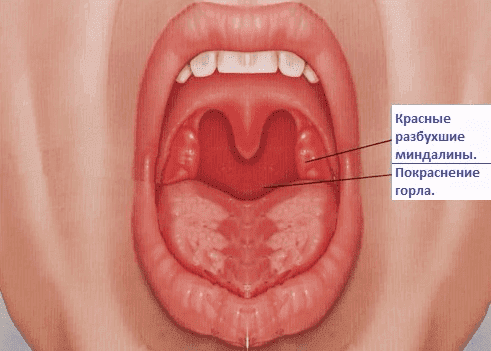
On photo-acute catarrhal tonsillitis
Catarrhal sinus is manifested with such symptoms:
- sore throat;
- temperature rise;
- headache;
- general weakness.
Of course, the most basic symptom of this form of tonsillitis remains a sore throat. This is due to the fact that all other signs are receding into the background because of their weak expression. Diagnosis of catarrhal angina reduces to the fact that the doctor examines the patient. During the examination, he will be able to detect swelling and redness of the tonsils. In addition, the tonsillar mucosa assumes the same appearance as the mucosa located near them. A distinctive feature of catarrhal angina from pharyngitis is that with it reddening is observed in the sky and back wall.
Lacunar
This form of tonsillitis has a fairly severe course, compared with catarrhal. They are characterized by severe pain in the throat, which leads to the fact that the patient is difficult to eat. Hence, there is a lack of appetite. Temperatures rise to 40 degrees.
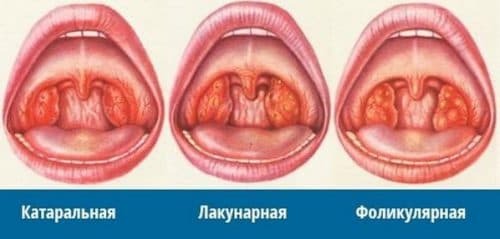
On photo-lacunar tonsillitis
In addition, the patient is visited by such signs:
- chills;
- headaches;
- weakness;
- pain in the ear;
- temperature rise up to 40 degrees;
- regional lymph nodes are enlarged and painful when palpated;
- pain syndrome in the extremities and lower back.
Follicular
With regard to follicular sore throat, follicles form during its course. They have the form of formations of yellow or yellowish-white hue. They pass through the amazed mucous membrane of the tonsils. Their size does not exceed the size of the head of the pin.
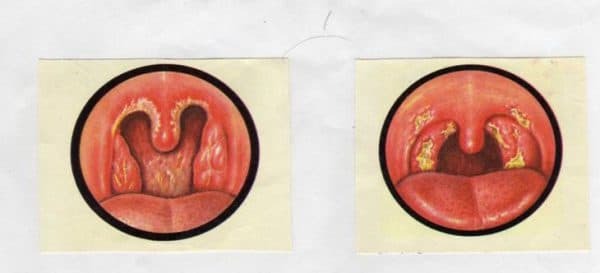
On photo-follicular tonsillitis
With follicular tonsillitis, lymph nodes are enlarged, and when they are plucked, they bring painful feelings to the patient. There are situations where follicular angina contributes to an increase in the spleen. The duration of this form of ailment will be 5-7 days. Observed are such symptoms as a rise in body temperature, diarrhea, vomiting, sore throat.
Lacunar
This form of tonsillitis is accompanied by the formation of lacunae. They have the form of purulent or whitish formations that affect the mucous membrane of the tonsils. Over time, they increase in size and affect the vast part of the amygdala.
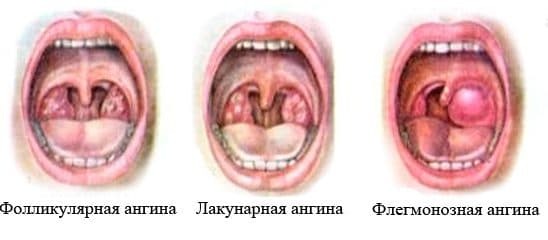
On the photo-lacunar tonsillitis
But that's beyond its education boundaries do not go. When removing lacunae, they do not leave bleeding wounds. The development of lacunar angina is similar to follicular, but only the flow is more severe.
Fibrious
For this affliction, the presence of a continuous plaque is characteristic. It can take a white or yellow color. In comparison with the previous forms of tonsillitis, where the plaque did not leave the borders of the tonsils, with fibrotic angina it can go beyond.
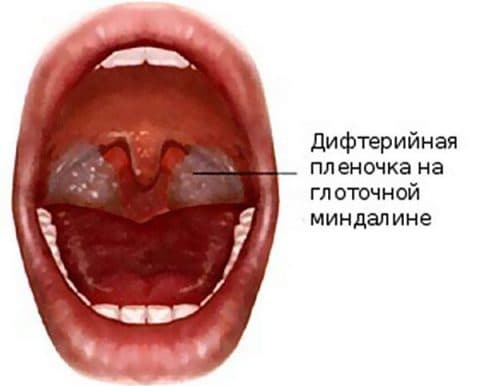
On the photo-fibrous angina
The film is formed during the first hours of the beginning of the pathology. The acute form is characterized by the presence of fever, headache, general weakness, lack of appetite. Against the background of these symptoms, brain damage can develop.
Reflux
This form of sore throat is rarely diagnosed. It is characterized by melting of the amygdala. Only one amygdala is affected.
Recognize the reflux form of tonsillitis possible for such symptoms:
- sharp pain in the throat;
- chills;
- weakness;
- copious salivation;
- body temperature 38-39 degrees;
- a bad smell.
When examining the paitsent, an increase in the lymph nodes can be detected, with palpation, they cause painful sensations. During the examination, the doctor will note the reddening of the palate on the one hand, puffiness and displacement of the palatine tonsil. Since the mobility of the inflamed soft palate has a limitation, when taking liquid food it can flow through the nasal passages.
If you do not start timely therapy, then on the tissues of the tonsils will begin to form an abscess. It is also called a perintosylar abscess. His autopsy can occur independently or have to use surgical methods.
On video, phlegmonous tonsillitis:
After the opening, the pathology develops in reverse. It may happen that reflux tonsillitis is delayed for 2-3 months, with an abscess from time to time. This kind of process can arise if the antibacterial drugs are misused or taken incorrectly.
 How to treat tonsillitis at home, and what tools should be used in the first place, will help to understand this article.
How to treat tonsillitis at home, and what tools should be used in the first place, will help to understand this article.
And here it is possible to heat a throat at a tonsillitis, and how much this agent effectively, is very much told here in article.
It will also be interesting to learn more about how the child's tonsillitis is treated: http: //prolor.ru/g/ bolezni-g /tonzillit/ u-detej-simptomy-i-lechenie.html
It will also be interesting to learn how to treat tonsillitis with folk remedies, and howthese tools can be used correctly, this article will help you understand.
Herpetic
This form of the disease is characterized by a rise in temperature, abdominal pain, vomiting, pharyngitis and the formation of ulcers that affect the posterior pharyngeal wall or soft palate. Influence on the development of herpetic sore throats can Coxsackie virus. Most often diagnose ailment in people in summer and autumn. Infection occurs when you are in contact with a sick person.
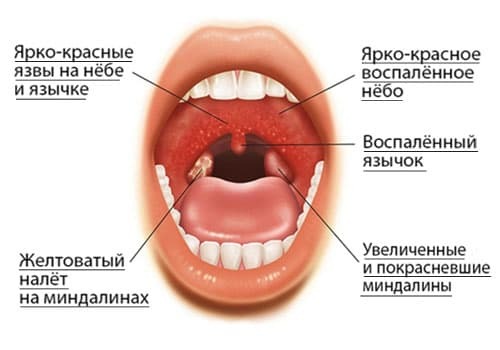
In the photo, the herpetic angina
looks like. At the initial stage of the disease, there is a rise in temperature indicators, general weakness, fatigue, irritability. After the person experiences a pain in a throat, plentiful allocation of a saliva, a rhinitis. Redness is formed on the tonsils, the sky and the posterior pharyngeal wall. Their mucous membranes are covered by vesicles, inside of which there is a serous fluid. Over time, they dry up, and in their place crusts form. With herpetic sore throat, diarrhea, vomiting and nausea may occur. For diagnosis, the doctor examines the patient and sends to the blood test.
Ulcerative-non-drug
The development of this form of angina is associated with reduced immunity and a lack of vitamins. The causative agent is a spindle-shaped rod. It is in the mouth of every person. Most often, the disease is diagnosed in the elderly. People who suffer from heart disease are also at risk.
Ulcerative necrotic angina has absolutely different symptoms, compared to the diseases described above:
- there is no rise in temperature;
- no sore throat and general weakness;
- there is a sensation of the presence of a foreign object in the throat;
- bad breath.
On video, ulcerative-non-narcotic sore throat:
During the examination of the patient, the doctor will be able to see a plaque of green or gray color. He is focused on the affected amygdala. After the removal of the plaque, there is a bleeding ulcer.
Which antibiotic for tonsillitis and pharyngitis is the best and most effective, is very detailed here in the article.
And here is how to use and use Lugol in tonsillitis in children, and how effective this tool will help to understand this information.
How is vacuum cleaning of tonsils with tonsillitis, and how effective this procedure is, is described in detail here in the article.
It will also be interesting to know whether it is possible to cure chronic tonsillitis, and whether it can be done at home.
What can be the consequences of the disease and the treatment of tonsillitis in pregnancy, and what means can I use, is indicated in this article.
Unspecified
This form of tonsillitis is accompanied by local and general manifestations. There is ulcerative necrotic lesion of the mucosa of the upper respiratory tract. Unspecified sore throat does not refer to independent ailments, but is a consequence of certain irritating factors.
Symptoms of the disease occur within a day. Characteristic of the high elevation of temperature indicators, general malaise and severe chills. An ulcerative necrotic process is formed on the tonsillar mucosa. If you do not start treatment, then the pathological process will begin to involve the oral mucosa. The inflammatory process will begin to affect periodontal tissue, which will lead to the formation of stomatitis and gingivitis.
On video, acute unspecified tonsillitis:
Acute tonsillitis today has a fairly extensive classification. Each of the presented species has its own clinical picture and therapy scheme. It is important to recognize the symptoms in time and to understand what kind of angina occurs and which pathogen is responsible for its occurrence. Treatment is prescribed only after a full diagnosis and diagnosis.
